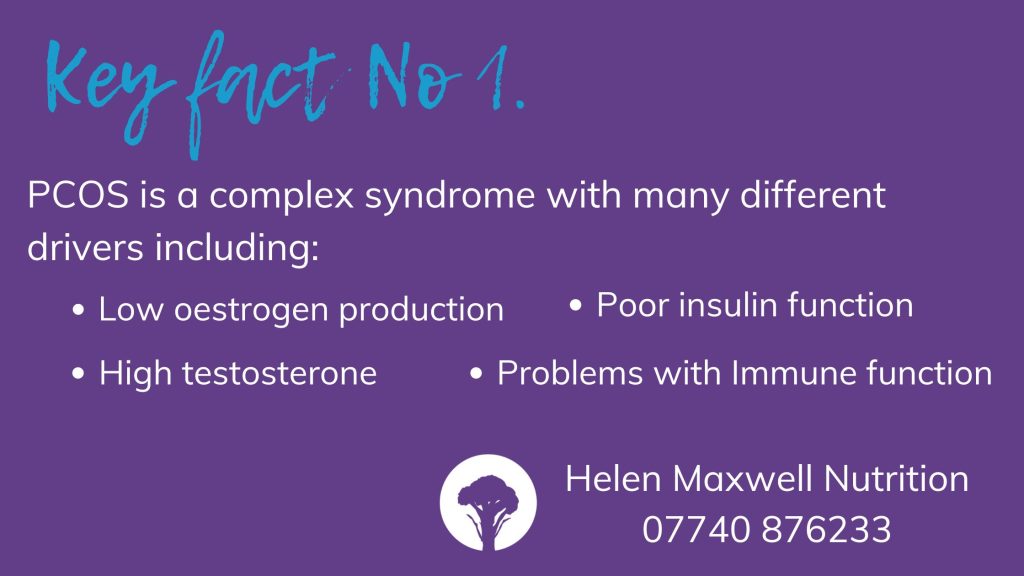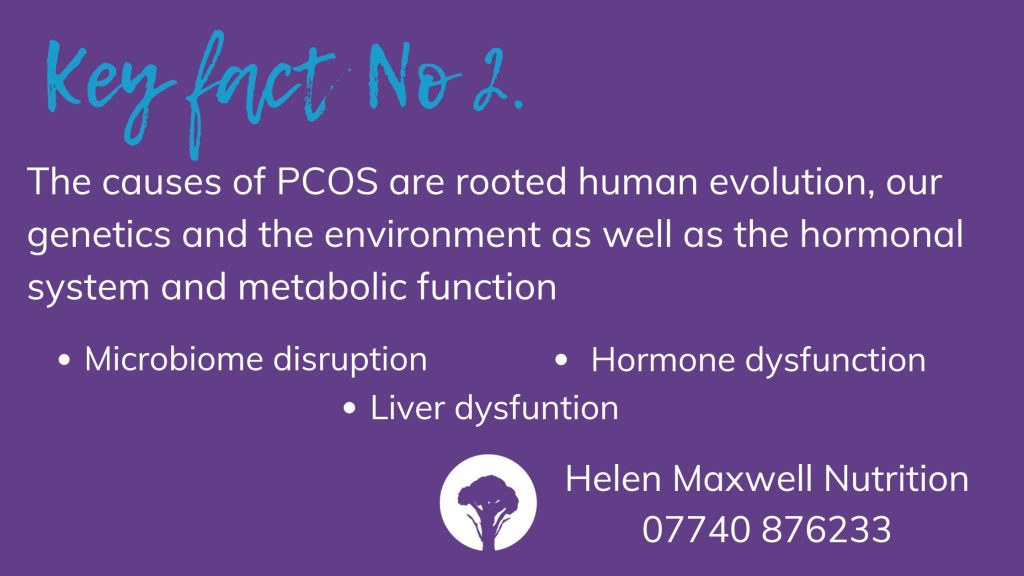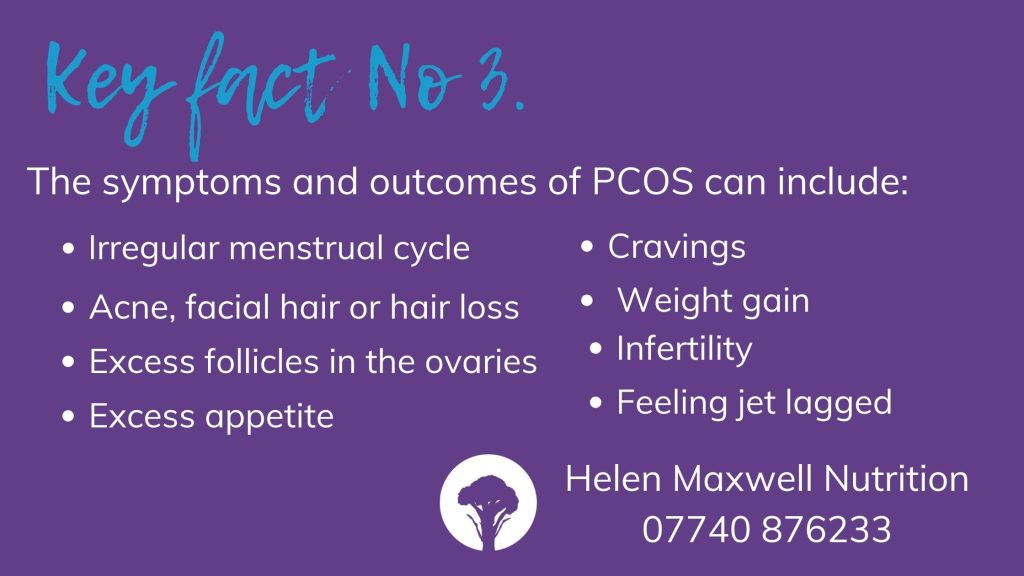
This is such a distressing condition especially for young girls. As I am seeing it in clinic and the incidence is rising I thought I would summarise some of the current scientific information and clinical approaches here.
For a diagnosis two out of the following three factors are required:

This occurs when cells stop allowing insulin to escort sugar (glucose) into the cells. It is very often but not always present in PCOS although the severity is variable. If glucose can’t get into the cell it gets deposited in the liver resulting in abdominal fat, hence insulin is often called ‘the fat storage hormone’. With no glucose (energy) in the cells clients often feel exhausted and hungry and therefore eat more, so a vicious cycle emerges. Food should generate energy but instead it’s stored as fat (weight) which the body doesn’t utilise, for various reasons, and the resulting lack of energy promotes more food intake. Weight gain, especially abdominal, is therefore a common feature of PCOS. Both glucose and insulin in the blood are undesirable over certain levels and will damage blood vessels.
Insulin resistance can be tested by measuring and testing for: fasting insulin; fasting glucose; an oral glucose tolerance test; Haemoglobin A1c and High sensitivity CRP levels. Some clients will react to very low glucose levels as the sugar levels in their blood drop, others will have low levels of insulin or may struggle to detox it from the body.
Oestrogen is required for many actions in the body including regulating metabolism and it is made from testosterone. The pituitary gland in the brain triggers luteinising hormone (LH) to signal testosterone which is converted to oestrogen by the ovaries. The conversion is carried out by an enzyme called aromatase which is initiated by a hormone called follicle stimulating hormone (FSH) also controlled by our pituitary gland. In PCOS this conversion isn’t working properly so oestrogen levels remain low and the brain keeps stimulating testosterone production. This then results in high testosterone levels which cause inflammation and overload the liver. Poor detoxification of testosterone and oestrogen can result and these metabolites tend to become toxic.
High androgens such as testosterone will be an issue for most PCOS clients because of the hormone cascade detailed above. High testosterone alters the gut microbiome which in turn results in greater testosterone production. A vicious cycle emerges of low oestrogen triggering LH, FSH and testosterone production resulting in high androgens which cause distressing acne and hair growth or loss symptoms
There are many Immune cells lining the gut which also contain oestrogen receptors. Dr Gersh considers oestrogen the master of the immune system for men as well as women. Oestrogen helps to turn inflammation on and off as required but also modulates the reaction to avoid a strong inflammatory chemical cascade. In PCOS, compared to controls, the threshold for inflammatory process activation is much lower. This inflammation can create all sorts of gut issues including toxicity and permeability resulting in dysbiosis and it’s many associated issues.
Genetically a mild defect in oestrogen production was an evolutionary benefit as slightly higher testosterone made women a little less fertile (fewer children) as well as stronger and braver. Modern times, chemical toxicity and the modern Western diet have twisted this advantage into a modern disease.
Many of the issues above start with metabolic dysfunction, which is the process of converting food into energy, in the gut and the liver.

The research is showing that plastics, phthalates (plasticisers), BPA, BPF, herbicides, heavy meals and air pollution present in the environment, in utero and during puberty cause hormonal and metabolic disruption, especially in women who are predisposed. These EDC’s can block, mimic or interfere with the body’s hormone system causing many health problems.
The gut lining and the enteric nervous system have oestrogen receptors which play a key role in the metabolism of food into energy. Low oestrogen levels can result in gut dysbiosis, gut permeability and poor gut motility (constipation). These factors in turn can lead to an increase in toxicity and inflammation for the liver to deal with.
Oestrogen is the master clock hormone and it co-ordinates our metabolic function in tune with our circadian rhythm. Over a third of our genes are clock genes and many others interact with these (60%). Dr Felice Gersh describes the body and it’s organs as an orchestra all tuned to our inbuilt circadian rhythm. Each and every one of your gut microbes (bacteria) has it's own circadian rhythm. So without sufficient oestrogen and poor absorption of what is produced, the body’s metabolism malfunctions. It thinks it’s day when its night and vice versa. Remember how awful you feel when you have jet lag? It’s the same scenario just a different cause.
The absence of food at the correct time is highly stressful, so the body will trigger cortisol. In response to this the liver will manufacture its own sugar (gluconeogenesis), for energy to respond to the ‘stressor’. This means the liver pours out sugar overnight thinking it is daytime, which triggers insulin which then stores as fat. In time this can lead to fatty liver. It is this overloaded and confused liver which results in the downstream effects of insulin resistance, poor detoxification and immune dysfunction known collectively as metabolic dysfunction.

PCOS sufferers are susceptible to weight gain for a number of reasons. Oestrogen regulates energy control (metabolism) and also appetite so low levels can result in increased appetite and poor energy generation. When we are tired we often over eat. In addition there may be insulin resistance which leads to fat storage. The metabolism and regulation of energy becomes very dysregulated hence the weight can increase. There are different types of PCOS however and a lean PCOS syndrome has also been identified.
In addition to low oestrogen production the receptors for oestrogen often malfunction in PCOS sufferers. Every organ in the body has oestrogen receptors and oestrogen connects metabolic and reproductive mechanisms. Pregnancy is inherently a metabolic stressor and in PCOS there are already many metabolic issues. Infertility is therefore a common downstream issue.
It can seem like a rather depressing picture and PCOS sufferers do have a lot of work to do. But the good news is by paying attention to diet and lifestyle there is a great deal that can be done.
PCOS can be helped dramatically with resetting circadian rhythm via obtaining light at the right time and eating at the correct times. In one study insulin and testosterone fell by over 50% in one month just by changing the structure of meals.
There are also various eating strategies which can ease pressure on the liver and help to regulate insulin function. Eating a very nutrient dense diet helps the microbiome to flourish so it’s important to work on the quality of food as well as the diversity and quantity. There are lots of therapeutic ways to nourish and rebuild the gut lining which in turn helps with reducing toxicity and supporting the immune system. We also work to support the liver which controls insulin production and whether we burn glucose or fat for energy.
In addition there are several supplements which I have found can really support clients with their energy generation and regulation and help with cortisol regulation. This does two things. It gives the client hope and also with less fatigue they have more energy to make the changes required.
Finally stress management is key as nervous system sympathetic tone is important. So breath work and meditation, yoga or alternative techniques can all help with this.
So the message is one of positivity and hope. By working in a personalised way we can support the body to make the changes required in a way that suits each individuals physiology and lifestyle.

References:
Parker et al, (2022) Polycystic Ovary Syndrome: An Evolutionary Adaptation to Lifestyle and the Environment Int. J. Environ. Res. Public Health 2022, 19(3), 1336; https://doi.org/10.3390/ijerph19031336
https://www.anhinternational.org/news/oestrogens-not-just-for-women/
https://yourlongevityblueprint.com/sos-pcos-part-1-dr-felice-gersh





